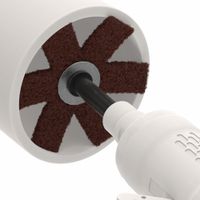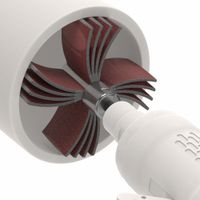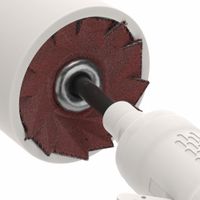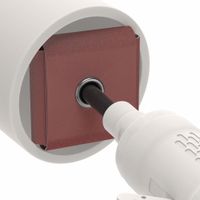Call +(254) 703 030 000 / 751 483 999 / 721 704 777
- Home
- Abrasives
- Sanding Abrasives
- Specialty Abrasives
.....Read More
Frequently Asked Questions
What are specialty abrasives used for in rotary tools?
Specialty abrasives in rotary tools are used for a variety of precision tasks that require specific material removal, surface finishing, or shaping. These abrasives are designed to handle tasks that standard abrasives might not efficiently accomplish, providing enhanced performance for specialized applications.
1. **Material Removal**: Specialty abrasives are used for removing material from hard-to-reach areas or intricate surfaces. They are ideal for tasks like deburring, where excess material needs to be removed from the edges of metal parts, or for cleaning welds and removing rust or corrosion from metal surfaces.
2. **Surface Finishing**: These abrasives are crucial for achieving a desired surface finish, whether it be a smooth, polished look or a textured finish. They are used in applications such as polishing metal, glass, or stone, where a high degree of smoothness and shine is required.
3. **Shaping and Contouring**: Specialty abrasives are employed to shape and contour materials, allowing for precise detailing and intricate designs. This is particularly useful in woodworking, metalworking, and jewelry making, where detailed craftsmanship is essential.
4. **Material Compatibility**: Different materials require different types of abrasives. Specialty abrasives are formulated to work with specific materials like ceramics, glass, stone, or composites, ensuring effective and efficient material processing without damaging the workpiece.
5. **Precision Work**: In industries like aerospace, automotive, and electronics, where precision is paramount, specialty abrasives are used for tasks that demand high accuracy and control, such as grinding, cutting, and drilling small or delicate components.
Overall, specialty abrasives enhance the versatility and capability of rotary tools, enabling them to perform a wide range of tasks with precision and efficiency, tailored to the specific requirements of the material and the desired outcome.
How do bore polishers differ from abrasive stars?
Bore polishers and abrasive stars are both tools used in the maintenance and finishing of firearm barrels, but they serve different purposes and function differently.
Bore Polishers:
1. Purpose: Bore polishers are primarily used to smooth and polish the interior surface of a firearm barrel. They help in removing minor imperfections and fouling, enhancing the barrel's performance and longevity.
2. Material: Bore polishers are typically made from softer materials like felt, cloth, or soft metal, which are impregnated with polishing compounds.
3. Function: They work by gently buffing the barrel's interior, providing a smooth finish without removing significant material. This process helps in reducing friction and improving bullet velocity and accuracy.
4. Application: Bore polishers are often used after cleaning the barrel to ensure a polished finish. They are not intended for aggressive material removal.
Abrasive Stars:
1. Purpose: Abrasive stars are designed for more aggressive cleaning and material removal within the barrel. They are used to remove stubborn fouling, rust, or other deposits.
2. Material: Abrasive stars are made from harder materials, such as steel wool or abrasive-coated materials, which can effectively scrub the barrel's interior.
3. Function: They work by scraping and abrading the barrel's surface, removing deposits and imperfections. This can help restore the barrel's condition but may also remove some of the barrel's material.
4. Application: Abrasive stars are used when a barrel requires more intensive cleaning or when there is significant fouling or corrosion. They are not typically used for regular maintenance due to their abrasive nature.
In summary, bore polishers are used for gentle polishing and maintenance, while abrasive stars are used for more aggressive cleaning and material removal.
What applications are cross buffs suitable for?
Cross buffs are suitable for a variety of applications across different industries due to their unique design and functionality. They are primarily used for polishing, deburring, and finishing tasks, especially in hard-to-reach areas or on complex surfaces. Here are some specific applications:
1. **Automotive Industry**: Cross buffs are used for polishing and finishing engine components, wheels, and other metal parts. They help in removing burrs and achieving a smooth surface finish, which is crucial for both performance and aesthetics.
2. **Aerospace Industry**: In aerospace, cross buffs are employed to deburr and finish turbine blades, engine components, and other critical parts. The precision and ability to reach intricate areas make them ideal for maintaining the high standards required in this industry.
3. **Metalworking**: Cross buffs are widely used in metal fabrication for deburring sharp edges, polishing welds, and finishing metal surfaces. They are effective on a variety of metals, including steel, aluminum, and brass.
4. **Jewelry Making**: Jewelers use cross buffs for polishing and finishing intricate designs and settings. Their ability to reach small and detailed areas makes them perfect for this delicate work.
5. **Medical Device Manufacturing**: In the production of medical devices, cross buffs are used to ensure smooth and burr-free surfaces on surgical instruments and implants, which is essential for safety and functionality.
6. **Woodworking**: Although less common, cross buffs can be used in woodworking to smooth and finish detailed carvings and intricate designs.
7. **General Maintenance and Repair**: Cross buffs are also used in maintenance and repair tasks for cleaning and polishing machinery parts, tools, and equipment.
Overall, cross buffs are versatile tools that provide effective solutions for finishing and polishing tasks in various industries, especially where precision and access to complex geometries are required.
How do cross pads adapt to changing cylinder dimensions?
Cross pads adapt to changing cylinder dimensions through their inherent design flexibility and material properties. These pads are typically used in honing processes, where they help in finishing the internal surfaces of cylindrical components. The adaptability of cross pads to varying cylinder dimensions is achieved through several mechanisms:
1. **Material Composition**: Cross pads are often made from abrasive materials bonded to a flexible backing. This flexibility allows the pad to conform to the surface of the cylinder, accommodating slight variations in diameter.
2. **Design Structure**: The cross pattern of the pads provides multiple contact points with the cylinder surface. This design ensures even pressure distribution and allows the pad to adjust to different diameters without losing contact or effectiveness.
3. **Spring-Loaded Mechanism**: Many honing tools equipped with cross pads use a spring-loaded mechanism that automatically adjusts the pressure exerted by the pads. This mechanism ensures consistent contact with the cylinder walls, regardless of minor dimensional changes.
4. **Adjustable Tool Holders**: The tool holders that house cross pads can often be adjusted to fit different cylinder sizes. This adjustability allows the same set of cross pads to be used across a range of cylinder dimensions.
5. **Wear Compensation**: As cross pads wear down, they naturally adapt to the cylinder's shape. This wear compensation helps maintain consistent performance over time, even as the pad material is gradually removed.
6. **Customizable Sizes**: Cross pads are available in various sizes and can be customized to fit specific cylinder dimensions, ensuring optimal contact and performance for each application.
These features collectively enable cross pads to effectively adapt to changing cylinder dimensions, ensuring efficient and uniform material removal during the honing process.
What advantages do overlap slotted discs offer over cross pads?
Overlap slotted discs offer several advantages over cross pads:
1. **Improved Cooling**: The slots in overlap slotted discs enhance airflow and heat dissipation, reducing the risk of brake fade during prolonged use. This is particularly beneficial in high-performance or heavy-duty applications where heat management is crucial.
2. **Enhanced Wet Performance**: The slots help channel water away from the disc surface, improving braking performance in wet conditions by maintaining better contact between the brake pad and disc.
3. **Consistent Performance**: Overlap slotted discs provide more consistent braking performance by continuously cleaning the brake pad surface. This reduces the buildup of debris and gases that can lead to uneven braking.
4. **Reduced Weight**: The design of slotted discs often results in a lighter component compared to solid discs, contributing to overall vehicle weight reduction and improved fuel efficiency.
5. **Aesthetic Appeal**: The aggressive look of slotted discs can enhance the visual appeal of a vehicle, which is often a consideration for performance and custom car enthusiasts.
6. **Improved Pad Bite**: The slots can increase the initial bite of the brake pads, leading to more responsive braking. This is advantageous in performance driving scenarios where quick response is necessary.
7. **Extended Pad Life**: By keeping the pad surface clean and free of debris, overlap slotted discs can contribute to longer brake pad life, reducing maintenance costs over time.
8. **Reduced Noise and Vibration**: The design can help minimize noise and vibration during braking, leading to a smoother and quieter operation compared to some cross pad designs.
Overall, overlap slotted discs are favored in applications where performance, cooling, and consistent braking are priorities.
In what scenarios are square pads most effective?
Square pads are most effective in scenarios where space optimization, alignment, and mechanical stability are crucial. They are commonly used in printed circuit board (PCB) design, particularly for surface-mount technology (SMT) components. The square shape provides a larger surface area for soldering, which enhances the mechanical bond between the component and the board, reducing the risk of detachment due to mechanical stress or thermal cycling.
In high-density PCB layouts, square pads can be more space-efficient compared to round pads, allowing for tighter component placement and more efficient use of board real estate. This is particularly beneficial in compact electronic devices where space is at a premium.
Square pads also facilitate easier alignment during the assembly process. The straight edges of square pads provide clear reference points for automated pick-and-place machines, improving the accuracy of component placement. This is especially important for components with fine pitch leads, where precise alignment is critical to avoid solder bridging and ensure reliable electrical connections.
Additionally, square pads are advantageous in applications requiring high current or thermal management. The increased surface area can accommodate larger traces, which helps in dissipating heat and handling higher current loads without overheating. This makes them suitable for power electronics and applications where thermal performance is a concern.
In summary, square pads are most effective in scenarios involving high-density PCB designs, precise component alignment, mechanical stability, and applications requiring enhanced thermal and current handling capabilities.
How do rotary flap peen assemblies enhance metal strength?
Rotary flap peen assemblies enhance metal strength through a process known as shot peening, which involves the controlled impact of small, high-velocity projectiles onto the surface of a metal component. This process induces beneficial compressive residual stresses on the surface layer of the metal, which counteracts tensile stresses that can lead to fatigue failure.
The rotary flap peening technique uses flexible flaps embedded with abrasive media, which are rotated at high speeds. As these flaps strike the metal surface, they create small indentations or dimples. The repeated impact of these flaps causes plastic deformation of the surface layer, leading to the redistribution of stresses. The compressive stresses introduced by this process are crucial because they help to close up micro-cracks and prevent the initiation and propagation of cracks under cyclic loading conditions.
This enhancement in metal strength is particularly beneficial in aerospace, automotive, and other high-stress applications where components are subjected to repeated loading and unloading cycles. By improving fatigue resistance, rotary flap peening extends the service life of components, reduces the likelihood of catastrophic failure, and enhances overall structural integrity.
Additionally, rotary flap peening is advantageous for its precision and ability to treat complex geometries and hard-to-reach areas, which are often challenging for traditional shot peening methods. It is also a more controlled process, allowing for consistent application of compressive stresses without significantly altering the surface finish or dimensions of the component. This makes it an ideal choice for delicate or precision-engineered parts where maintaining tight tolerances is critical.






